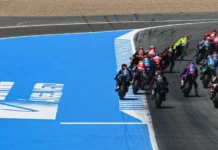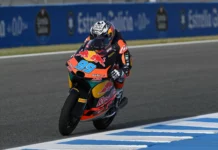As seen on www.amaproracing.com/ridersonly
General – All Classes
No. 02-1
Current rule: Official starting line for each starting row will be plainly marked, approximately 25 feet between each row.
Proposed change: The official starting line for each starting row will be plainly marked with approximately 30 feet between each row to form a grid. The starting positions on the rows will be staggered backward from the pole side of the grid resulting in slightly diagonal starting lines. Approximate stagger from position to position will be one meter. Each starting position will have a front and a rear grid mark, approximately 12″ apart, representing the area where the front tire contact patch (the area of the front tire touching the track surface) must be located for a rider to be properly staged.
Reasons for change: This style of grid is currently used by the FIM. It provides for a more equitable representation of qualifying positions than straight across starting lines. This configuration may also have advantages for grid personnel who must watch for jump starts.
Implementation: January 1, 2002
Comment on this rule: 02-1
——————————————————————————–
No. 02-2
Current rule: Should a rider’s rear axle cross the designated front grid mark at the green light signal, the rider will be considered to have jumped the start and a penalty will be assessed.
Proposed change: Should a rider’s front axle cross the designated front grid mark at the green light signal, the rider will be considered to have jumped the start and a penalty will be assessed. This allows a rider virtually no movement before the start is signaled.
Reasons for change: This should result in more equal starts than allowing the “rolling” as in the past. Again, the grid personnel may be able to see jump starts easier as well.
Implementation: January 1, 2002
Comment on this rule: 02-2
——————————————————————————–
No. 02-3
Current rule: Refueling after the warm-up lap at the back of the grid is permitted.
Proposed change: Refueling after the warm-up lap will not be permitted.
Reasons for change: This is an unnecessary procedure considering the length of our races, fuel capacities and fuel consumption of current motorcycles. It can also cause delays in the start, fuel spills and confusion on the grid.
Implementation: January 1, 2002
Comment on this rule: 02-3
——————————————————————————–
No. 02-4
Current rule: Riders listed in the top ten in points of a particular class, currently or at the end of the previous season, will be permitted a total of one provisional start per season in that class.
Proposed change: Riders who are currently, or at the end of the previous season, listed in the top ten in points in one or more classes, will be permitted one provisional start per season in each of those classes.
Reasons for change: We have a number of riders that are eligible in more than one class for a provisional start. These riders will be allowed a provisional start in each class in which they are eligible rather than a total of one provisional in a season.
Implementation: January 1, 2002
Comment on this rule: 02-4
——————————————————————————–
No. 02-5
New rule: Riders dropping out of a race on the same lap will be scored in the order that they last crossed the finish line.
Reasons for new rule: This occurs occasionally and is not addressed in the rule book at present. Clarification is needed to ensure consistency in scoring this type of situation.
Implementation: January 1, 2002
Comment on this rule: 02-5
——————————————————————————–
Superbike
No. 02-6
Current rule: When a race is restarted following a red flag, a rider who was present at the starting grid but was unable to start or dropped out after the start, is permitted to restart on a back-up motorcycle using the following procedure:
(1) Rider must obtain permission from the Chief Steward or the Race Manager.
(2) Rider will be gridded on the last row of the restart grid.
Proposed change: When a race is restarted following a red flag, a rider who was present at the starting grid but was unable to start or dropped out after the start, is permitted to restart on a back-up motorcycle until two laps have officially been completed (leader has crossed the finish line to begin the third lap) using the following procedure:
(1) Rider or crew must obtain permission from the Chief Steward or the Race Manager.
(2) All back-up motorcycles must be staged on pit lane or designated area and identified to grid officials.
(3) Rider will be gridded on the last row of the restart grid in a position determined by scoring.
Reasons for change: The current rule is not restrictive enough to prevent its abuse throughout a long race or a race that has multiple red flags. In addition, the current rule does not specifically stipulate that back-up bikes should be staged on the pit lane.
Implementation: January 1, 2002
Comment on this rule: 02-6
——————————————————————————–
No. 02-7
Current rule: A bright orange flag indicates that the pace car is being dispatched. All riders are to hold position in regard to passing other competitors, but are instructed to close up the distance on riders ahead of them.
Proposed change: The pace car flag will be changed to make it more distinctive and may be used in conjunction with a warning light/signage system. The procedures will also be changed to provide a longer warning period before the car is actually dispatched onto the racing surface.
Reasons for change: There were complaints by riders at Daytona this year that the orange flag was difficult to distinguish from the yellow flag and therefore caused confusion. A long warning period is needed to allow the field to settle down and regroup before the pace car actually takes to the track.
Implementation: January 1, 2002
Comment on this rule: 02-7
——————————————————————————–
600/750 SuperSport
No. 02-8
Current rule: The original equipment airbox and air filter must be utilized.
Proposed change: The original equipment airbox must be retained but the air filter may be replaced with an aftermarket filter designed to exactly replace the original OEM filter.
Reasons for change: Aftermarket filters are normally less expensive than OEM filters and are accepted by the rules in other organizations such as WERA.
Implementation: January 1, 2002
Comment on this rule: 02-8
——————————————————————————–
No. 02-9
Current rule: The original cooling system thermostat must be in place and not modified.
Proposed change: The original cooling system thermostat may be removed or modified.
Reasons for change: The thermostat is not needed and costs nothing to remove. A nonfunctioning thermostat could lead to overheating and possibly a fluid spill on the track.
Implementation: January 1, 2002
Comment on this rule: 02-9
——————————————————————————–
No. 02-10
Current rule: The 750 SuperSport regulations currently do not allow exceptions for twin-cylinder motorcycles to have additional modifications or to be larger in displacement than 750cc.
Proposed change: The following displacement limits for twin cylinder four-strokes will be permitted:
600cc – 750cc four-stroke liquid-cooled twin cylinders
700cc – 1350cc four-stroke air-cooled twin cylinders
Twin cylinder four-strokes will be allowed the same modifications currently allowed in the Pro Thunder class with the exception of tires. The Pro Thunder minimum weight of 380 pounds will apply.
Reasons for change: This change will give the Buells and Ducati 748’s another program to compete in. Additional brands in the competition could enhance and individualize the class as well.
Implementation: January 1, 2002
Comment on this rule: 02-10
——————————————————————————–
250 Grand Prix
No. 02-11
Current rule: Fluid containment fairings are required on all four-stroke motorcycles.
Proposed change: Fluid containment fairings will be required on all motorcycles.
Reasons for change: Two-stroke 250 Grand Prix motorcycles have been exempt from this rule. Experiences with oil and coolant spills this season have shown that two-stroke motorcycles should be equipped with the fluid containment fairings as well.
Implementation: January 1, 2002
Comment on this rule: 02-11
2002 MOTOCROSS/SUPERCROSS PROPOSED RULE CHANGES
125 Class
No. 02-1
Current rule: The minimum weight requirement for 125 class motorcycles is 194 pounds. This also applies to the 250cc four-stroke motorcycles allowed in this class.
Proposed change: Any four-strokes larger than 125cc must weigh a minimum of 216 pounds.
Reasons for change: Our experience has shown that the four-stroke 250cc Yamaha’s race track performance is comparable to the 125cc two-strokes in most conditions. However, to maintain future competition parity and reduce or maintain costs, we propose this weight differential which approximates the current four-stroke 250 Yamaha’s race weight and is the same as the minimum 250 class weight.
Implementation: January 1, 2002
Comment on this rule: 02-1
——————————————————————————–
250 Class
No. 02-2
Current rule: The minimum weight requirement for 250 class motorcycles is 216 pounds. This also applies to the 251cc-550cc four-stroke motorcycles allowed in this class.
Proposed change: Any four-strokes larger than 250cc must weigh a minimum of 224 pounds.
Reasons for change: As in the 125 class, our experience with 400cc-550cc four-strokes in the 250 class indicates that their race track performance is comparable to the 250cc two-strokes in most conditions. However, to maintain future competition parity and reduce or maintain costs, we are proposing this weight differential which approximates the current four-strokes’ race weight.
Implementation: January 1, 2002
Comment on this rule: 02-2
——————————————————————————–
General – All motocross classes
No. 02-3
Current rule: Riders earn race points in each of the motos according to their respective finish positions. Winners are determined on the basis of total points earned in all motos, except qualifying and consolation motos. In case of a tie, the winner of the tie will be determined on the basis of points earned in the final moto.
Proposed change: Each championship event shall consist of two races per class. Riders will be awarded points according to their respective finish in each race.
Reasons for change: To simplify the current process of declaring a race winner and to broaden the appeal of the sport through television. Each moto as a stand alone race provides the opportunity to create 30 minute blocks of television programming, resulting in improved scheduling options. The change, while not affecting the current championship points structure, will provide more opportunities for teams, sponsors and participants to promote race victories.
Implementation: January 1, 2002
Comment on this rule: 02-3
——————————————————————————–
No. 03-1
Current rule: There are no restrictions on modifications or replacement of forks and shocks in motocross.
Proposed change: The current 125 Supercross suspension rule will be adopted for motocross. Replacement and modification of forks and shocks will be limited to the following:
(1) Forks and shocks must be either stock or aftermarket units listed on the Approved Equipment List. This list is available from the AMA office or at Tech Inspection.
(2) Originally approved inner and outer fork tubes, axle lugs, cartridge, and piston rod must be retained but may be modified. All other fork parts may be replaced.
(3) Originally approved shock body, shaft, and reservoir must be retained but may be modified. All other shock parts may be replaced.
(4) AMA must receive written notification from the manufacturer of any superseding of controlled parts before those parts may be utilized in competition. A current manufacturer’s parts list reflecting the superseded part must accompany the notification.
(5) Approved forks, shocks, and superseded parts must be available in the U.S. through dealers or distributors to AMA Pro-licensed 125 class riders for the entire current season. Legitimate orders accompanied by a 50% deposit must be filled within 15 days of receipt by the dealer or distributor. Failure to fill a legitimate order may result in the canceling of the component manufacturer’s eligibility.
(6) Retail prices of approved forks and shocks may not exceed the following:
Both forks (less triple clamps) $3,500.00
Shock assembly $1,000.00
Reasons for change: These regulations were originally enacted in Supercross to reduce costs and provide more equality in equipment between private/support teams and factory teams. This should be carried over into motocross for the same reasons plus it eliminates the need for teams to develop two completely different types of suspension components.
Implementation: January 1, 2003
Comment on this rule: 03-1
——————————————————————————–
No. 03-2
Current rule: 250 Class Engine Displacements – 150cc-250cc 2-strokes, 251cc-550cc 4-strokes
Proposed change: The maximum displacement for four-strokes will be 450cc.
Reasons for change: In accordance with our agreement with the FIM and the manufacturers for worldwide consistency in motocross class displacements, the maximum displacement of 450cc for four-strokes was determined to be acceptable by most parties. In addition to consistency, continuing parity as four-stroke technology advances and clear separation from 500 class motorcycles are the goals. The FIM decided that 2003 would be the implementation date and AMA Pro Racing agreed.
Implementation: January 1, 2003
Comment on this rule: 03-2
Proposed AMA Pro Racing Rule Changes For 2002
Proposed AMA Pro Racing Rule Changes For 2002
© 2001, Roadracing World Publishing, Inc.






